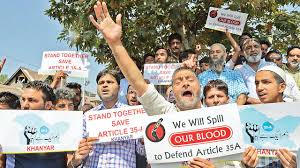With both India and Pakistan locking horns after the recent Pulwama attack, a heated debate is going around on Article 35A. Speculations are rife that the Article might be abrogated. But before reaching to any conclusion we must understand what if Article 35 A is abrogated.
A PIL filed in Supreme Court of India for abrogation of Article 35A which is questioning its validity. The important part of the PIL and the main legality issues pointed is:
“Article 35A was not added to the Constitution by following the due procedure prescribed for amendment of the Constitution of India under Article 368. Article 370 does not anywhere confer on the President legislative or executive powers so vast that he can amend the Constitution or perform the function of Parliament. It has been brought about by the executive organ when actually the right of amendment of the Constitution lies with the legislative organ. Therefore, it is, allegedly, ultra vires the basic structure of the Constitution since it violates the Constitutional procedures established by law. It also questions the bill against women rights and equality as women lose their inheritance rights if married outside.” (1)
Let us analyse the legal ramifications of abrogating Article 35A.
Well what is Article 35A?
Article 35A of the Indian Constitution is an article that empowers the Jammu and Kashmir state’s legislature to define “permanent residents” of the state and provide special rights and privileges to those permanent residents.
It was added to the Constitution through a Presidential Order, that is, The Constitution (Application to Jammu and Kashmir) Order, 1954 – issued by the President of India on 14 May 1954, exercising the powers conferred by the clause (1) of the Article 370 of the Indian Constitution, and with the concurrence of the Government of the State of Jammu and Kashmir. (2)
Can Article 35A be abrogated?
The answer is big NO. Article 35A was issued in exercise of the powers conferred by clause (1) of article 370 of the Constitution, the President, with the concurrence of the Government of the State of Jammu and Kashmir made a series of Presidential orders.
The High Court of Jammu and Kashmir, in October 2015, has ruled that the Article 370 cannot be “abrogated, repealed or even amended.” It ruled that the clause (3) of the Article conferred power to the State’s Constituent Assembly to recommend to the President of India on the matter of the repeal of the Article.
Since the Constituent Assembly, before its dissolution in 1957, did not make such a recommendation, the Article 370 has taken on the features of a “permanent provision” despite being titled a temporary provision in the Constitution.
On 3 April 2018, the Supreme Court of India gave a similar opinion declaring that the Article 370 has acquired a permanent status. It further stated that, since the State Constituent Assembly has ceased to exist, the President of India would not be able to fulfil the mandatory provisions required for its abrogation. (3)
So if Article 35A has to be amended or abrogated again it cannot fulfil the mandatory provisions required under Article 370, since Article 35A is a part of series of presidential orders exercised under Article 370 of the Constitution.
Is Article 35A anti-women and against gender equality since women lose inheritance rights?
The answer is no. This issue that was pending for over 26 years, was settled in 2002 by a Full Bench of the Jammu and Kashmir High Court headed by Justice V K Jhanji, which, after hearing the matter ruled that J&K women marrying outsiders wouldn’t lose their right to a share in ancestral property, right to work, education, inheritance and even adoption. (4)
If Article 35A is abrogated by force?
In the very first para of Constitutional order 1954 it is mentioned:
(1) This Order may be called the Constitution (Application to Jammu and Kashmir) Order, 1954.
(2) It shall come into force on the fourteenth day of May, 1954 and shall thereupon supersede the Constitution (Application to Jammu andKashmir) Order, 1950.
Well here is the catch. The Constitution order 1954 supersedes the Presidential order 1950. If the Order is abrogated, then the Presidential order 1950 would come into force and applied to the state of J&K.
The Presidential order of 1950, officially The Constitutional Order 1950 applicable to State of Jammu and Kashmir, came into force on 26 January 1950 contemporaneously with the Constitution of India.
The order specified the subjects and articles of the Indian Constitution that corresponded to the Instrument of Accession as required by the clause b(i) of the Article 370.
Thirty eight subjects from the Union List were mentioned as matters on which the Union legislature could make laws for the State.
So what are the Implications of abrogating Article 35A?
Implications
Noted Lawyer Zaffar Shah of State High Court argues, “In my view the Petition before the Supreme Court deserves to be dismissed in keeping with the earlier decisions delivered by the Court.
Further, Article 35A has been added in the Constitutional Application Order 1954 and by questioning it, the entire Constitutional Application Order will have to be questioned.
If the Court rules that Constitutional Application Orders are invalid, such a judgment will have to be made applicable to all the Constitutional Application Orders from 1950 till date.
The Constitutional link between the Union and the State will be snapped and the position of the State will be same as it was before constitutional arrangements were worked out. It will also affect various provisions of the Constitution of the State and result in Constitutional crisis.” (5)
If the legal challenge succeed and Article 35A is abrogated, this can open the doors for the invalidation of all subsequent Presidential orders almost 41, each of which was an amendment to, or modification of the 1954 presidential order.
As per the report by State Autonomy Committee, through these Presidential orders the central government extended 94 out of 97 entries in the Union List to Jammu and Kashmir, and made applicable to the State of Jammu and Kashmir 260 out of 395 articles of the Indian Constitution.
They have been used to issue provisions and make changes, which include – replacing the elected Sadr-e-Riyasat (President of the State) with a Governor chosen by the Centre; changing the “Prime Minister” of the state to Chief Minister; extending the powers of the Supreme Court and Election Commission to Jammu and Kashmir; and preventing the state Assembly from making any amendment to the Jammu and Kashmir Constitution.
These Presidential orders have infact been quite handy for the Center in Jammu and Kashmir to impose direct rule on Jammu and Kashmir. In case of Punjab, for example, to impose the Presidential rule, the Centre had to amend the Constitution quite often.
Thus the Presidential order 1954 is the mother of all presidential orders. Abrogation of the Presidential order 1954 would lead to abrogation of all subsequent orders/amendments, thus restricting the Centre’s relation with Jammu and Kashmir pre-1954, where the Centre’s Powers were restricted to Foreign Affairs, Defence and Communication only.
In this way with abrogation of Article 35A, Kashmir will become Autonomous as it was pre-1954. The relationship of center and state will be same as it was mentioned as per instrument of Accession (restricted to three main categories) and Article 370.
References
(1) https://www.dailymail.co.uk/indiahome/indianews/article-3262348/J-K-government-vows-defend-special-status-Article-35A.html
(2) http://www.jklaw.nic.in/constitution_jk.pdf
(3) https://indianexpress.com/article/india/india-news-india/j-k-high-court-says-article-370-is-permanent-cant-be-abrogated-repealed-or-amended/
(4) http://archive.indianexpress.com/news/explained-do-j-k-women-lose-their-right-to-share-in-ancestral-property-if-they-marry-a-nonstate-subject-/1202457/
(5) https://www.greaterkashmir.com/article/news.aspx?story_id=196811&catid=55&mid=53&AspxAutoDetectCookieSupport=1
Feroz Hafiz
hafizferoz@gmail.com





